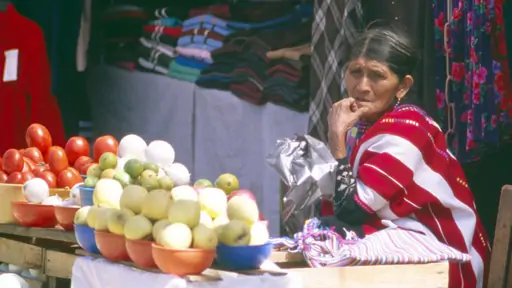Indigenous Calendar December, 2013: A Tzeltal Maya Woman Trades Fruit on Market Day

In Mexico — as well as in surrounding countries like Guatemala and Belize — there are still many Maya peoples. Although they no longer belong to the great historical civilization known as the Maya Empire, they are the direct descendents of ancestors that were part of that empire hundreds of years ago.
In the central highlands of Chiapas State, Mexico, live a Maya sub-group known as the Tzeltal and there are around a third of a million of them. Surprisingly, the way they live today has much in common with the lifestyle of their ancient ancestors. One example is the language they speak. The Tzeltal language began branching into its own distinct form around eight hundred years ago. Most Tzeltal people today still speak it as their first or second language alongside Spanish.
Traveling in the area the inquisitive visitor is welcomed into many Tzeltal communities. An interesting site is the firing of pottery using the pre-Columbian technique of placing the clay in an open fire instead of a kiln. Some Tzeltal communities are famed for their craft of producing art pottery this way. Residents of the small town of Amatenango del Valle near San Cristóbal de las Casas have turned this practice into a tourist trade. Here, young girls make art pottery in the form of small trinkets known locally as animalitos (little animals) specifically to sell to tourists.
Probably the least changed aspect of Tzeltal life is basic economy and commerce. The Chiapas central highlands are still a region of little urbanization. Rural Tzeltal communities here have traditionally been able to produce small amounts of surplus food and livestock. So the main form of commerce is still the trading of this surplus at weekly municipal markets (there are over a hundred of them in Chiapas). In fact this is the lifeblood of economic life in Tzeltal communities.
I was in the municipal capital Oxchuc (a Tzeltal word that means three knots) near the Guatemalan border on market day. While I declined to try one of the local delicacies — rat soup — I did enjoy some local fresh fruit. Scenes of Tzeltal women selling fruit were ubiquitous and I took many photos. Sorting through them after I returned home this one struck me the most. Apart from the bowls being plastic instead of clay this photo could have easily been taken hundreds of years ago.
The Tzeltal Maya are featured in our documentary, Ancient and Modern Mayan Peoples.
Read more about the Tzeltal people.
If you enjoyed reading this article, please consider supporting independent, advertising-free journalism by buying us a coffee to help us cover the cost of hosting our web site. Please click on the link or scan the QR code. Thanks!


